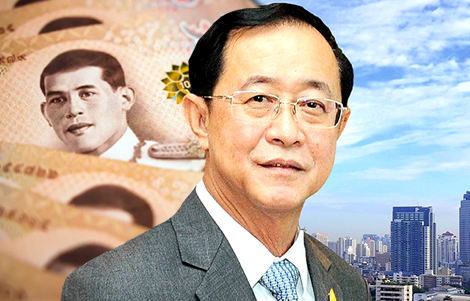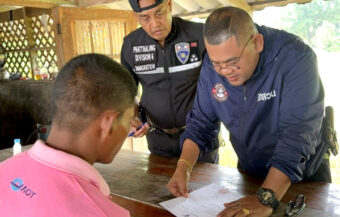Thailand’s Finance Minister said on Wednesday that 2.8% growth, itself dependent on a return of foreign tourists in large numbers in 2021, was not adequate for the kingdom’s long term goals. He was speaking with Reuters. Arkhom Termpittayapaisith said, at that rate, it would be 2023 or 2024 before the country had recovered to where it was in 2019 meaning 5 lost years. It comes as a former Thai senior official with a UN agency, Supachai Panitchpakdi, urged the government not to be afraid to borrow and use fiscal stimulus even if it means breaching the country’s legally set 60% ratio to GDP limit.
Economic planners within the government are becoming concerned about prospects for a full return of foreign tourism demand in 2021 to prime the economy and achieve the level of growth necessary to begin recovery from last year’s record contraction. The timing of this is critical to save the country’s ailing foreign tourism industry which is now a key source of concern. It comes as the Thai baht reached a 4 month low against the US dollar this week with an upsurge in demand for Thai exports. The former Thai United Nations senior official urged the government not to be afraid to borrow money to bridge the gap.

A top economist and former Secretary-general of a UN agency has urged the government to be prepared to exceed the country’s 60% of GDP borrowing legal threshold, at this time, to drive the economy forward.
Supachai Panitchpakdi, formerly with the UN Conference on Trade and Development, compared the Covid-19 virus situation to a wartime emergency and pointed to higher debt to GDP ratios being tolerated in developed countries.
Developed countries at 100% of GDP, Thailand in January reached 52% and is projected to rise to 57%
The United Kingdom ended 2020 with close to a 100% of GDP borrowing level while the United States has a similar ratio after record levels of stimulus expenditure to prime the economy.
By contrast, Thailand, which is ever mindful of the devastating Asian Financial Crisis of 1997, had a debt to GDP ratio of 52% at the end of January this year.
Under carefully calibrated plans being managed by the Finance Ministry, this figure is predicted to extend to 57% of GDP when it fully draws down the ฿1 trillion loan facility put into place last year by the Public Debt Management Office.
2.8% growth projected this year with export growth and at least 5 million foreign tourist arrivals
Thailand is currently set to achieve 2.8% growth this year if the country can reopen successfully to foreign tourism and bring in 5 million visitors.
This is dependent on both external demand and the kingdom’s vaccination programme which aims to use 63 million vaccine doses to inoculate over 54% of the adult population by the end of the year.
However, Dr Yong Poovorawan of Chulalongkorn University’s Faculty of Medicine on Friday said it will take 100 million doses to effectively achieve herd immunity in Thailand to guarantee the country can return to normality.
The top medical expert urged the government to procure these additional doses as a priority.
Even 2.8% is too low for the kingdom to recover
The Minister of Finance, Arkhom Termpittayapaisith, said in his interview that the projected 2.8% growth figure for 2021 was too low.
He was speaking to Reuters on Wednesday and explained that a growth figure like this for this year, would be on the basis of last year’s severe contraction of the economy, the worst that Thailand has seen since the Asian Financial Crisis in 1997.
‘That isn’t what we are happy about because the output gap is about 7%,’ the minister said.
Minister Arkhom said, at that rate, it would be 2023 or 2024 before the kingdom was back on track or back to 2019 levels.
This would mean 5 lost years of economic growth potential. This was not where the country needed to be based on its medium and long term goals.
Concerns rising that efforts to relaunch the foreign tourism industry in 2021 may not bear fruit
The minister appeared to indicate that he was still concerned that foreign tourism may not return in 2021 despite his own ministry officials, in the last few weeks, insisting that the target of 5 million visitors for 2021 be maintained.
The minister, while insisting that the financial situation was stable, pointed to the use of Covid-19 loan funds to launch an asset warehousing scheme to assist in the recovery of the country’s tourism industry.
Officials work on asset warehouse plan to relaunch the tourism industry
‘Demand from overseas might not return yet this year, that’s why government measures are still needed to shore up the domestic economy,’ he pointed out.
Timing is critical to relaunch plan and funding
The government still has ฿500 billion out of the ฿1 trillion Covid 19 loan to assist Thai firms, particularly in the tourism sector to recover from the Covid-19 crisis.
However, the use of these funds, as with the asset warehouse scheme, must be timed to coincide with full and unfettered access to the kingdom for foreign tourists.
Former top UN official Supachai urged the government to borrow as if on a war footing
Mr Supachai, thinking along the same lines, urged the government to aggressively pursue fiscal stimulus measures to boost and develop the kingdom’s economy this year especially in the agriculture and tourism sectors.
‘We are in an economic survival mode, so public borrowing and higher public debt are normal. The government has more room to increase public debt to support the economic recovery,’ he explained. ‘We are in a war with the virus, so we need more resources, including money, to fight this unusual situation. If we fight in a normal manner, we will lose.’
Politically sensitive issue after the 1997 crisis
However, raising the public debt to GDP ratio would present the government with a political challenge.
The question of public borrowing levels was repeatedly raised by opposition parties in parliament during the government censure debate in February.
Politicians and the Thai public have long memories when it comes to 1997.
Thai baht falls to a 4 month low this week as bond prices rose in the United States in a marked change
There is some good news for the government outside the kingdom.
The Thai baht, this week, fell to a 4 month low against the US dollar at ฿30.50 as market sentiment in the United States shifted sharply with an increasing value placed on bonds and rising borrowing costs.
This corresponds with a surge in the price of oil spells spelling a revival of the world economy which may feed itself into inflationary fears. This may mean a tightening of fiscal policy in the future.
Either way, it has resulted in a stronger dollar which makes Thai exports more competitive.
It may well be that the Thai government has already achieved the right balance but simply needs to reopen the foreign tourism economy while exports already look set to rise.
Join the Thai News forum, follow Thai Examiner on Facebook here
Receive all our stories as they come out on Telegram here
Follow Thai Examiner here
Further reading:
Vaccination campaign begins in early morning jab event but hopes for more foreign tourists set back
Economy to rebound as the year progresses driven by exports and a return of mass foreign tourism
Door closing on quick foreign tourism return as economic recovery is delayed to the end of 2022
Industry leaders and central bank all warn that foreign tourism must return to avoid a collapse
Fact – only 6,556 visitors arrived in Thailand last month compared to 3.95 million in December 2019
Desperate foreign tourism business concerns are clinging to straws as they try to survive the crisis
Challenge of the virus and closure to tourism leads to major long term changes in the Thai economy


















